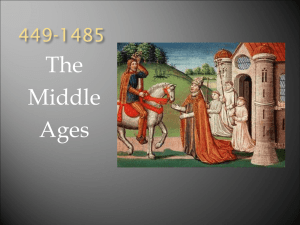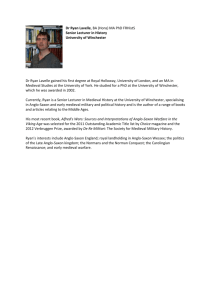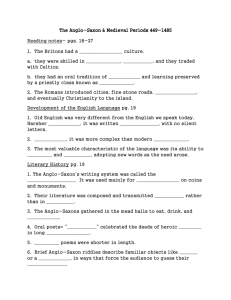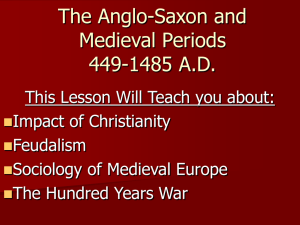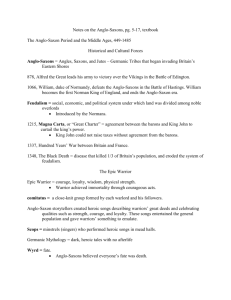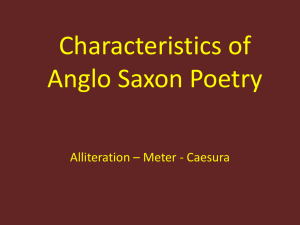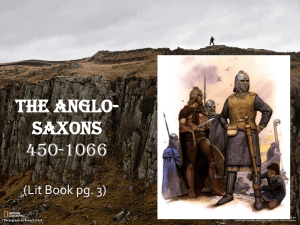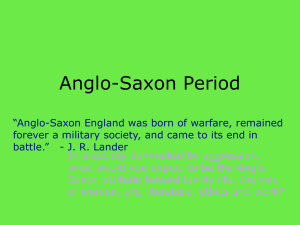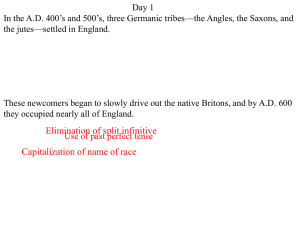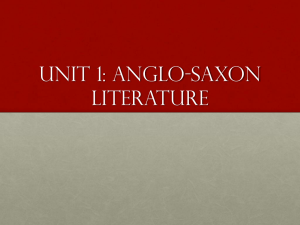Anglo-Saxon History
advertisement
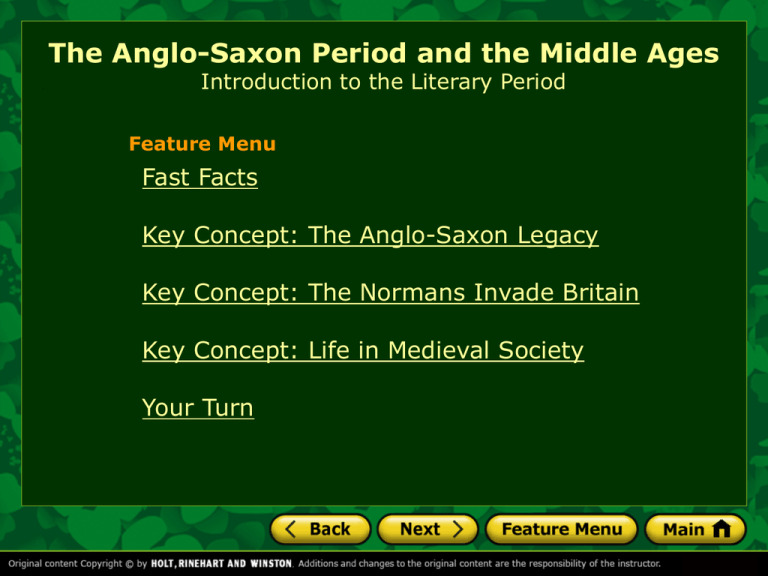
The Anglo-Saxon Period and the Middle Ages Introduction to the Literary Period Feature Menu Fast Facts Key Concept: The Anglo-Saxon Legacy Key Concept: The Normans Invade Britain Key Concept: Life in Medieval Society Your Turn The Anglo-Saxon Period and the Middle Ages Fast Facts Historical Highlights • The Romans invade Britain in 55 B.C. and create a four-hundred-year period of political stability. • King Alfred and his descendants unite AngloSaxon England in the late ninth century. • William the Conqueror defeats the Anglo-Saxons in 1066 and introduces feudalism to Britain. The Anglo-Saxon Period and the Middle Ages Fast Facts Literary Highlights • The brooding fatalism of pagan Anglo-Saxon culture gives the first British epic, Beowulf, its melancholy tone and stress on earthly heroism. • The bards ensure stories have an important position in early British culture. • Christian monks copy ancient manuscripts, preserving classical and Anglo-Saxon texts. • Chivalry gives rise to a new form of literature, the romance. [End of Section] Key Concept: The Anglo-Saxon Legacy History of the Times • After the legions of Rome conquered the Celts, Roman armies kept Britain free from invaders. • Troubles at home forced Rome to evacuate its soldiers in A.D. 409, opening Britain to invasion. Key Concept: The Anglo-Saxon Legacy History of the Times • Angle and Saxon clans impose warrior culture on the island for six centuries. • Until ninth century, Britain is subject to constant invasions and battles. • King Alfred unites Anglo-Saxons against the invading Danes. • The spread of Christianity helps unify the Anglo-Saxons. Key Concept: The Anglo-Saxon Legacy • • • • Literature of the Times Anglo-Saxon literature is rooted in oral tradition. Poetry, like fighting, hunting, and farming, had great significance. Bards relied on sound devices and repeated phrases to remember their tales. Old English epic poem Beowulf combines Germanic heroism and Anglo-Saxon fatalism. Key Concept: The Anglo-Saxon Legacy Literature of the Times • English emerges as a written language. • Christian monks copy ancient manuscripts, preserving classical and Anglo-Saxon texts. • Historical poems in AngloSaxon Chronicle detail events of early English history. Key Concept: The Anglo-Saxon Legacy Comprehension Check What event led to the Anglo-Saxon invasion of the British provinces? [End of Section] Key Concept: The Normans Invade Britain History of the Times • In the Norman invasion of 1066, William the Conqueror defeats the Anglo-Saxons. • To squash revolts, William divided the land among his loyal barons and built castles around the country. • By establishing a social structure called feudalism, William created a hierarchy of rulers under one lord and a network of thousands of knights sworn to serve him. Key Concept: The Normans Invade Britain Literature of the Times • Old English disappears from laws and literature after William makes French the language of the state. • Reflecting the chasm between the British masses and the Norman rulers, literature was usually written in Latin or Norman French after 1066. • Bibles and gospels created in monasteries were celebrated for their brilliant illuminated manuscripts, all created by hand. Key Concept: The Normans Invade Britain Comprehension Check How was William the Conqueror able to form such a powerful army following his victory in 1066? [End of Section] Key Concept: Life in Medieval Society History of the Times • Medieval society was dependent on strictly defined social classes—nobility, knights, priests, merchants, and peasants. • The contributions of each group affected how well villages and towns prospered. • Villages, built around castles, were the fundamental center of medieval society. • Social mobility was nearly impossible in the Middle Ages. Social rank remained fixed. Key Concept: Life in Medieval Society Literature of the Times • Some medieval writers began to use the vernacular, or language of the people. • Works written in English, such as ballads and romances, helped to define England’s identity. • A new literary form—the romance—becomes popular, reflecting the concepts of courtly love and chivalry. • Scholarly works from monasteries and universities reflect society’s interest in moral instruction and morality plays. Key Concept: Life in Medieval Society Comprehension Check Describe the trends in English literature during the Middle Ages. Were they reflective of life at the time? [End of Section] The Anglo-Saxon Period and the Middle Ages Introduction to the Literary Period Your Turn Copy the Academic Vocabulary list into a notebook. Try to use the words as you outline the main ideas of the selections in the collection that follows. concept status diverse attribute emphasis [End of Section] The End
